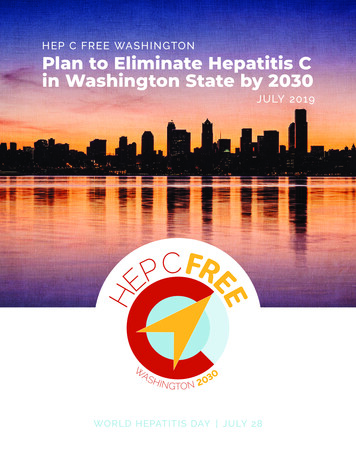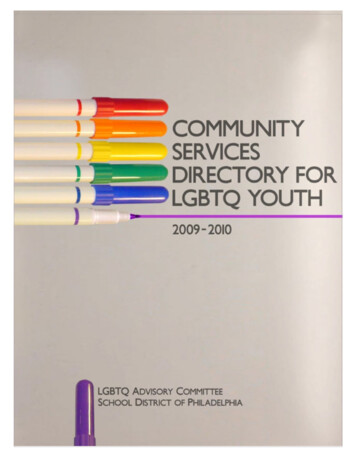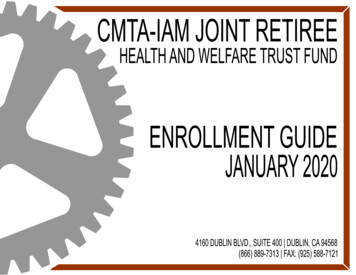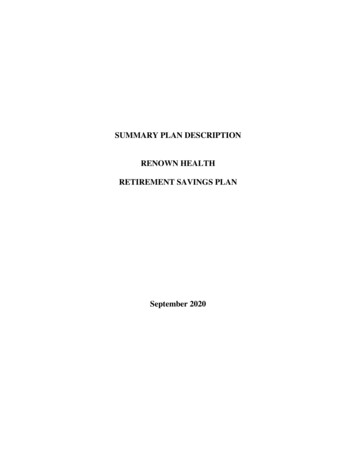
Transcription
HEP C FREE WA SHINGTONPlan to Eliminate Hepatitis Cin Washington State by 2030JULY 2019WORLD HEPATITIS DAY JULY 28
For more informationHep C Free Washingtonc/o Washington State Department of HealthDivision of Disease Control & Health StatisticsOffice of Infectious DiseaseP.O. Box 47840 Olympia, WA .wa.gov/HepCFreeWA150-NonDOHFor persons with disabilities, this document is available in other formats.Please call 800-525-0127 (TTY 711) or email civil.rights@doh.wa.gov.
Contents1Executive Summary3Introduction6 Priority Populations for Hepatitis C in Washington State8 Stigma Experienced by People Living with Hepatitis C9 Hep C Free WA — The State Hepatitis C Elimination Initiative15Recommendations15 Overarching Coordination Goal17 Data & Strategic Information Goals24 Community-Based Responses & Interventions Goals31 Clinical Strategies Goals39Implementation Phase and Next Steps40Conclusion41Appendices43 Appendix A: Report by the Center for Disease Analysis Foundation,Public health impact of a population based approach to HCV treatmentin Washington61 Appendix B: Directive of the Governor 18-1365 Appendix C: Washington State Health Care Authority,Hepatitis C Clinical Policy73 Appendix D: Glossary75EndnotesBack Hep C Free WA Community Partners
Hepatitis C Free Washington (Hep C Free WA)Who we are: A collective impact initiative seeking a multisector response to the public healththreat of hepatitis C.Our vision: A world free from hepatitis C.Our mission: Working together to eliminate hepatitis C in Washington State by the year 2030.Our values: Easy access for all. Hep C Free WA believes all people at risk for and living with hepatitis Cshould have easy access to testing, care, and a cure for hepatitis C. Uphold the dignity of each person. Hep C Free WA believes we must reduce hepatitis Crelated stigma, recognize the worth of affected communities, and ensure whole-person careto eliminate hepatitis C and promote wellness. Clear communication. Hep C Free WA strives to educate all Washingtonians about hepatitisC, including how to prevent hepatitis C, where to get tested, and how to get cured. Health equity. Hep C Free WA works so that all communities impacted by hepatitis Creceive what they need, including services that are culturally relevant and in language theyunderstand, to prevent, diagnose, and cure hepatitis C and achieve the highest level ofhealth and wellbeing. Innovative solutions. Hep C Free WA seeks new and creative ideas to address hepatitis C bycentering the voices of those disproportionately impacted and pairing community wisdom andstrengths with the best available data.
Executive SummaryThe hepatitis C virus (HCV) is a public health crisis in Washington State. At the beginning of 2018, anestimated 59,100 Washingtonians were living with HCV. In September 2018, Governor Inslee issuedDirective of the Governor 18–13 (the Directive), “Eliminating Hepatitis C in Washington by 2030 throughcombined public health efforts and a new medication purchasing approach.” In response to the Directive,the Washington State Department of Health brought together a broad range of partners to develop theHep C Free Washington initiative. With a shared mission of eliminating HCV in Washington State by theyear 2030, the partners developed a set of recommended goals and actions to achieve the mission.Hep C Free WA GoalsOverarching Coordination Goal1. Ensure implementation of the Hep C Free WA recommendations in order to achieve HCV eliminationby 2030.Data and Strategic Information Goals2. Identify data sources and strategies to strengthen the characterization of HCV disease burden withinWashington State.3. Obtain resources and build capacity for continuous data monitoring, evaluation, quality improvement,and reporting.4. Identify and track data metrics using currently available data.5. Determine metrics using data not yet available or accessible.Community-Based Responses and Interventions Goals6. Improve access to and use of preventive and health care services in non-clinical settings throughexpansion and co-location of services.7. Improve access to and use of clinical care and supportive services by sufficiently scaling coverage andwidening the scope of community-based navigation and case management programs.8. Increase HCV awareness, resources, and education, and reduce stigma.Clinical Strategies Goals9. Improve access to and use of clinical care for marginalized populations at risk for or living with HCVthrough innovative service delivery models.10. Build the capacity of the health care workforce to diagnose and treat HCV.11. Improve diagnosis of HCV in primary care settings.12. Improve HCV disease intervention services.13. Improve access to HCV treatment and comprehensive health care.14. Improve the ability of people taking HCV direct-acting antivirals to complete treatment.15. Improve follow-up clinical care for people who have completed HCV treatment.H EP C FR EE WA S H I N GTO NPlan to Eliminate Hepatitis C in Washington State by 20301
Hep C Free Washington Coordinating Committee and Work Group MembersJulie Akers, PharmD, BCACP (Washington State University)Kathy Lofy, MD (Washington State Department of Health)Hilary Armstrong, MPH (Public Health – Seattle & King County)Bob Lutz, MD, MPH (Spokane Regional Health District)Amanda Avalos, MPA (Washington State Health Care Authority);Co-chair, Data & Strategic Information Work GroupKrista Lynch Concannon (Washington State Health Care Authority)Scott D. Bertani, MNM (Lifelong AIDS Alliance)Jaymie Mai, PharmD (Washington State Department of Labor &Industries)Lauren A. Beste, MD, MSc (University of Washington & VA PugetSound Health Care System)Aleks Martin, MSW, CDP (Hepatitis Education Project)Jessica Blose, CDP, LMHC (Washington State Health CareAuthority)Vanessa McMahan, PhD, MS (People’s Harm Reduction Alliance)Tarrah Calender, MN, RN (VA Puget Sound Health Care System)Stella Chang (Washington State Health Care Authority)Jim Coffee (Cowlitz Family Health Center)Jasmine Matheson, MPH (Washington State Department of Health)Brittany Millard-Hasting, MD (Northwest Integrated Health)Bethany Mizushima (Grays Harbor Public Health & Social Services)Thea Mounts (Washington State Office of Financial Management)Meaghan Munn, MPH (Public Health – Seattle & King County)Emily Colgate, MD (CHAS Health)Carri Comer (Washington State Department of Health)Sarah Deutsch, MPH (Washington State Department of Health)Warren Dinges, MD, PhD (Seattle Infectious Disease Clinic)Jeff Duchin, MD (Public Health – Seattle & King County)Leta Evaskus (Washington State Health Care Authority)Tessa Fairfortune, MPH (Washington State Department of Health)Mary Fliss, MHA (Washington State Health Care Authority)Erik Ness, MD, M.Phil.Kara Nester, MPH (Washington Health Benefit Exchange)Michael Ninburg (Hepatitis Education Project)Shana Paulsen, MPH (Washington State Department of Health)Ryan Pistoresi, PharmD, MS (Washington State Health CareAuthority)Willie Rhodes, Jr., BBA, M.Div. (Washington State Department ofHealth)Mary P. Goelz, RN/PHN (Pacific County Public Health and HumanServices)Jessica Rienstra, RN (Lummi Tribal Health Center)Monica Graybeal, PharmD (Yakima Valley Farm Workers Clinic);Co-Chair, Clinical Strategies Work GroupErick Seelbach, MAT (Pierce County AIDS Foundation)William Hayes, PharmD (Washington State Department ofCorrections)Mark Springer (Spokane Regional Health District)Edgar Hernandez-Garcia, MSW, LICSW (VA Puget Sound HealthCare System)Leah Hole-Marshall, JD (Washington Health Benefit Exchange)Emalie Huriaux, MPH (Washington State Department of Health)George Ioannou, MD, MS (University of Washington & VA PugetSound Health Care System); Co-chair, Data & Strategic InformationWork GroupMeg Jones, JD (Association of Washington Healthcare Plans)Patrick Judkins (Thurston County Public Health & Social Services)John Scott, MD, MSc (University of Washington)Alisa Solberg, MPA (Tacoma-Pierce County Health Department)Kim Steele-Peter, MPH (Tacoma-Pierce County HealthDepartment)Jason Sterne (Hepatitis Education Project); Chair, CommunityBased Responses & Interventions Work GroupJon Stockton, MHA, BS (Washington State Department of Health)Lara Strick, MD, MSc (Washington State Department ofCorrections & University of Washington)Donna Sullivan, PharmD, MS (Washington State Health CareAuthority); Co-Chair, Clinical Strategies Work GroupDanielle Kenneweg, MPA (Washington State Department of Health)Kathryn Szymanowski (Tacoma Needle Exchange, Dave PurchaseProject)Asif Khan, MD (Northwest Integrated Health)Judith Tsui, MD, MPH (University of Washington)Jennifer Lam, MPH (Washington State Department of Health)Thomas Weiser, MD, MPH (Portland Area Indian Health Service)Malika Lamont, MPA (Public Defender Association)Sydney Wilson (community member)Jessica Leston, DrPH, MPH (Northwest Portland Area Indian HealthBoard)Wendy T. Wong, RPh (Providence Centralia HospitalPharmaceutical Care Clinic)Scott Lindquist, MD, MPH (Washington State Department ofHealth)Judy Zerzan, MD, MPH (Washington State Health Care Authority)H EP C FR EE WA S H I N GTO NPlan to Eliminate Hepatitis C in Washington State by 20302
Introduction“Hepatitis” means inflammation of the liver. There are many causesof liver inflammation, including heavy alcohol use, toxins, somemedications, and certain medical conditions. Hepatitis is often causedby a virus (known as “viral hepatitis”). A virus that primarily attacks theliver, causing inflammation, is called “hepatitis,” followed by a letter(e.g., A, B, C, D).The three most common forms of viral hepatitis in the United Statesare hepatitis A virus (HAV), hepatitis B virus (HBV), and hepatitis C virus(HCV). Although each can cause similar symptoms, they are spread indifferent ways and can affect the liver differently. Hepatitis A is usually a short-term (acute) infection that goes awayon its own. It spreads through oral-fecal contact, such as throughcontaminated food or water. This can happen when a person with HAVdoes not adequately wash their hands and prepares or serves food. Itcan also spread during oral-anal sex contact (“rimming”) with someonewith HAV). There are vaccines to prevent HAV. There is no specificmedical treatment for HAV. Hepatitis B can also begin as a short-term infection, but in somepeople the virus remains in the body and causes lifelong (chronic)infection. More than 90% of infants that are infected develop chronicHBV infection. In otherwise healthy adults, only 5-10% of thoseinfected develop chronic HBV infection. For the other 90% of adults,the infection will go away on its own. Hepatitis B spreads throughblood-to-blood contact (e.g., sharing of needles and syringes, sharingof medical equipment such as glucose monitoring devices) or whensexual fluid from someone living with HBV enters the body of someonewithout the virus (e.g., through condomless sex). A pregnant personliving with HBV can transmit the virus to their child at birth. ManyH EP C FR EE WA S H I N GTO NPlan to Eliminate Hepatitis C in Washington State by 20303
people will not have any noticeable symptoms for many years, butduring this time the virus damages the liver. Like HAV, there arevaccines to prevent HBV. Most people diagnosed with chronic HBVinfection need medical treatment for the rest of their lives. Whilenot a cure, the medication helps reduce the risk of liver disease andprevents the spread of HBV to others.Every year HCV killsmore people than over60 other CDC-reportableinfectious diseasescombined, including HIV,HBV, and tuberculosis.H EP C FR EE WA S H I N GTO N Hepatitis C can also begin as a short-term infection (occurring withinthe first six months after someone is exposed to the hepatitis C virus).It spreads through blood-to-blood contact. For about 75% of people,the virus stays in the body and becomes a chronic (lifelong) infectionif left untreated. Many people will not have any noticeable symptomsfor many years, but during this time the virus damages the liver.Unfortunately, there is no vaccine to prevent HCV. However, new alloral medications called “direct acting antivirals” (DAAs) can cure theinfection in almost all patients in as little as eight weeks with minimalor no side effects.Hepatitis C is the most common bloodborne (spread by blood) infectionin the United States. The United States Centers for Disease Control andPrevention (CDC) estimate that about 2.4 million people are living withHCV in this country, but the actual number could be much higher. In theUnited States, reported cases of acute (new) HCV infection increased350% from 2010 through 2016 (from 850 to 2,967 reported cases),rising each year during this period. This increase reflects new infectionsassociated with rising rates of injection-drug use, and, to a lesserextent, improved testing and case detection. Several investigations ofnewly acquired HCV infections found that most occurred among youngpersons (20-39 years old) who inject drugs. Most new cases of acuteHCV are not identified or reported to public health because most adultsand adolescents with HCV do not have symptoms. The CDC estimates41,200 new HCV infections happened in 2016.1 In the United States,HCV is a leading cause of liver cancer and one of the leading causesof liver damage resulting in the need for liver transplant. In addition,HCV has extrahepatic manifestations — in other words, HCV can causeconditions outside of the liver. For example, HCV is associated withhematologic, endocrine, neurologic, cardiovascular, and renal disease.2Every year HCV kills more people than over 60 other CDC-reportableinfectious diseases combined, including HIV, HBV, and tuberculosis.Plan to Eliminate Hepatitis C in Washington State by 20304
Figure 1: HCV Care Cascade, Washington, 2%20,00095%7,30010,000Viremic InfectionsBeginning of 2018DiagnosedThrough 2018Treated7,000During 2018CuredSource: Center for Disease Analysis Foundation report, 2019 (Appendix A)In 2018, there were 188reports of acute HCVinfection in Washington,the most since 1995.The HCV “treatment cascade,” sometimes called the “care cascade,”outlines the sequence of steps or continuum of services critical foraddressing the testing, linkage to care, and treatment needs of peopleliving with HCV.3 Figure 1 uses projections developed by the Centerfor Disease Analysis Foundation based on the best available data inWashington (Appendix A). It shows that while a high proportion ofpeople living with HCV (labeled as “viremic infections) know their HCVstatus (labeled as “diagnosed”), few of them were actually connected tocare and received HCV treatment in 2018. In Washington State, at thebeginning of 2018, 79%, or 46,500, of the estimated 59,100 people(using a 95% uncertainty interval, 32,500-71,500 people is the possiblerange) living with chronic HCV were diagnosed. Of the total number ofpeople living with HCV, 12% (7,300) were treated. Of the 7,300 treated,95% (7,000) were cured. In 2018, it was estimated that about 2,950Washingtonians were newly infected with HCV (39.9 per 100,000).In Washington State, HCV poses a significant public health threat. Onaverage, at least 582 people die from HCV-associated causes eachyear. From 2001 to 2010, an average of 24 cases of acute HCV infectionwere reported each year. Similar to national trends, since 2011, thenumber of acute cases in the state has risen dramatically. This reflectsa rise in injection drug use associated with increased opioid andmethamphetamine use, as well as improved detection of acute infectionby health care providers. In 2018, there were 118 reports of acute HCVinfection in Washington, the most since 1995. The number of chronicHCV cases reported to public health agencies has also increased. From2001 to 2010, there were an average of 5,322 newly reported chronicHCV cases yearly. In 2016, there were 8,118 and, in 2017, there were8,839 new reports. At this time, the data for 2018 are not finalized,but the number of chronic case reports is expected to be higher thanprevious years. Increases of chronic case reports are due to the rise inpeople injecting drugs, and improved testing — including universal onetime testing of Baby Boomers (people born from 1945 through 1965) andrisk-based HCV testing — as recommended by the CDC.4H EP C FR EE WA S H I N GTO NPlan to Eliminate Hepatitis C in Washington State by 20305
Figure 2: Age Shift among Chronic HCV Cases in Washington State, 2007 and 2017Age Distribution of Chronic HCV Cases in Washington, 2017Age Distribution of Chronic HCV Cases in Washington, 200716001400Baby BoomersBaby Boomers14001200Number of CasesNumber of 14 5 -19 0 -24 5 -29 0 -34 5 -39 0 -44 5 -49 0 -54 5 -59 0 -64 5 -69 0 -74 5 -79 0 -841012233445757686 850-45-9-14 5 -19 0 -24 5 -29 0 -34 5 -39 0 -44 5 -49 0 -54 5 -59 0 -64 5 -69 0 -74 5 -79 0 -848676734534521021Age in Years 85Age in YearsSource: Washington State Department of Health, Hepatitis Surveillance RecordsFrom 2007 to 2017 thestate had a noticeableshift in the age distributionof newly reported chroniccases. This indicatestwo epidemics of chronicHCV — one among BabyBoomers and one amongyounger persons who werelikely infected by sharingdrug injection equipment.From 2007 to 2017 the state had a noticeable shift in the agedistribution of newly reported chronic cases. This indicates two epidemicsof chronic HCV — one among Baby Boomers (indicated by the grayshaded areas in Figure 2), and one among younger persons (peopleunder the age of 40 in 2017) who were likely infected by sharing druginjection equipment. In 2007, 68.6% of chronic cases were among BabyBoomers and 21.9% were among people under 40. In 2017, 52.2% ofchronic cases were among Baby Boomers and 31.0% were among peopleunder 40 (see Figure 2). People who were infected with HCV decadesago are at high risk of cirrhosis and liver cancer. People who inject drugs,including those who are living with HCV, are also at high risk of otherhealth problems including overdose, skin and soft-tissue infections, HIVinfection, and fulminant (severe and sudden) hepatitis caused by HAV orHBV co-infection.Priority Populations for Hepatitis C inWashington StateIdentifying priority populations who are impacted by HCV more thanothers helps focus public health and treatment efforts toward those mostaffected and address health disparities. In addition to Baby Boomers andpeople who inject drugs, other priority populations include people whohave experienced incarceration, people living with HIV, African Americans,and Native Americans.People in jails or prisonsWhile about 1% of the population of the United States is living withHCV, the rates among people in correctional institutions (i.e., jails andprisons) are much higher. Recent estimates of the rate of chronic HCVinfections in U.S. prisons is 17.4%5 to 23.1%.6 Correctional populationsrepresent about one third of total HCV cases in the United States.7Populations most affected by incarceration, such as people who injectdrugs, are more likely to be at risk for or living with HCV. About 11–15% ofpeople incarcerated at any one time in Washington State Department ofCorrections facilities are living with chronic HCV.8H EP C FR EE WA S H I N GTO NPlan to Eliminate Hepatitis C in Washington State by 20306
People living with HIVNationally, AmericanIndian/Alaska Nativeshave the highest rates ofacute HCV and a rate ofdeath related to HCV thatis 2.7 times higher thannon-Hispanic whites.African Americans areabout 11% of the U.S.population, but theyrepresent 25% of peopleliving with chronic HCV.In the United States, about 1 in 5 people living with HIV have evidence ofpast or present HCV infection. As both HIV and HCV can be transmittedthrough direct blood-to-blood contact (e.g., sharing equipment for druginjection), having both HCV and HIV infection (co-infection) is commonamong people who inject drugs. An estimated 62-80% of people whoinject drugs who are living with HIV are also living with HCV.9 10 11 Sexualtransmission of HCV is generally rare, but possible. An increasing numberof studies show that sexual transmission of HCV is an important modeof HCV acquisition among men who have sex with men who are livingwith HIV.12 13 14 15 Activities that may increase vulnerability to HCV includecondomless anal sex, sharing of unsterilized sex toys, and non-injectiondrug use (e.g., smoking or snorting stimulants like methamphetamine,or inhaling “poppers”).16 Hepatitis C can accelerate liver disease inpeople living with HIV.17 18 19 20 21 Of people newly diagnosed with HIV inWashington in the year 2018, 10% had acute or chronic HCV infection.Of all people living with HIV in Washington at the end of 2018, 9% hadchronic HCV infection.22 Recent studies have shown that acute HCVmay be impacting men who have sex with men who are not living withHIV. Vigilance may be needed to address the prevention needs of thispopulation.23 24African Americans and Native AmericansAlthough nearly 75% of race/ethnicity data is not provided on HCV casereports submitted to the Washington State Department of Health, othersources of national and state data show there are significant HCV-relateddisparities among African Americans and Native Americans.African Americans are about 11% of the U.S. population, but theyrepresent 25% of people living with chronic HCV.25 This disparity isparticularly evident among African Americans ages sixty and older, wherethe rate of HCV is 10 times higher than among older individuals of otherraces in the United States. In addition, HCV-related illness and death arehigher among African Americans than among people who identify withother races.Nationally, American Indian/Alaska Natives have the highest rates ofacute HCV26 and a rate of death related to HCV that is 2.7 times higherthan non-Hispanic whites.27 A recent analysis by the Northwest PortlandArea Indian Health Board found that, during 2006-2012 in WashingtonState, American Indian/Alaska Native residents had a higher rate of HCVassociated death when compared to non-Hispanic whites.28H EP C FR EE WA S H I N GTO NPlan to Eliminate Hepatitis C in Washington State by 20307
Stigma Experienced by People Living withHepatitis CBecause of the relationship between HCV transmission and druginjection, people living with and those cured of HCV report socialchallenges telling people about their status. They report concern thatthey may be perceived as having injected drugs, whether they have ornot, and therefore treated poorly in their communities, including by healthand social service providers. Stigma may lead to isolation and withdrawalfrom medical care.29During two community events held in May 2019, one in Seattle and onein Spokane, participants spoke powerfully about their experiences livingwith HCV. The selected quotes provided below underscore the importanceof addressing HCV-related stigma and offering opportunities for peopleaffected by HCV to discuss their experiences and learn from each other.There is a stigma that onlycertain people get HCV —anyone can get it. “You kept [HCV] quiet, you didn’t say anything.” “I’m co-infected [with HIV and HCV] and I got treated [and cured for HCV]and got re-infected It was a lot harder to talk to my provider a secondtime I felt their disappointment.” “[When I first found out I was living with HCV] I told my husband it wasscary.” “There is a stigma that only certain people get HCV — anyone can get it.” “I didn’t tell anyone — I was ashamed big time. I told my mom becauseshe had it. I went to [a substance use treatment program] and talked to acounselor and that helped.” “You can feel really lousy after addiction and some providers treat youcrappy.” “I had co-infection with HIV and hep C. It really sucked. I would talk tosomeone [living] with HIV online, but when I told him I also had hep C Igot turned down [for a hook up] and rejected so I stopped disclosing thehep C I stopped telling anyone about hep C.” “People are really uneducated about hep C. My sister didn’t want to sharemy soda or my soap in the shower. It hurt.” “Everyone wanted to know how I got [HCV] and I didn’t know. I just toldeveryone I was a child of the 70s — sex, drugs, and rock n roll.” “I had neck surgery and got hooked on Dilaudid and eventually startedinjecting [heroin]. It was devastating to find out I had hep C I got amassage and told the massage therapist I had headaches related tomy hep C treatment and that’s why I was there. She walked out and cameback and said, ‘My supervisor says it’s okay to touch you Do you haveany open sores?’ I felt like I had the plague. I’m so ashamed because ofmy addiction. I haven’t really told anyone except one of my daughters My self-esteem is in the toilet.” “It was embarrassing and I’m ashamed of what I did to my life and I’mreally grateful for being treated [for HCV]. I don’t feel like I’m worth it.”H EP C FR EE WA S H I N GTO NPlan to Eliminate Hepatitis C in Washington State by 20308
Hep C Free Washington —The State Hepatitis C Elimination InitiativeThe tools exist to eliminatethe public health threat ofHCV in Washington, butcurrently resources arenot available at the levelneeded to achieve thisgoal.Hepatitis C elimination is defined as a state where HCV is no longer apublic health threat and where those few people who become infectedwith HCV learn their status quickly and access curative treatment withoutdelay, preventing the spread of the virus. There is a global conversationabout HCV elimination occurring, both at the World Health Organization30and in a number of countries (e.g., Georgia31, Australia32, Scotland33).While the United States does not have a federally supported national HCVelimination strategy, the National Academies of Sciences, Engineering &Medicine released A National Strategy for the Elimination of HepatitisB and C (2017),34 and the U.S. Department of Health & Human Servicesdeveloped the National Viral Hepatitis Action Plan, 2017–2020.35In addition, a number of Tribal Nations (e.g., Lummi Nation36, CherokeeNation37) and state and local jurisdictions (e.g., San Francisco38, NewMexico39, New York State40) are working on HCV elimination strategies.The clock is ticking as HCV-related illness and death rise. Almost allpeople living with HCV can be cured with a short-course, well-tolerated,all-oral treatment. Scaled up HCV treatment paired with prevention ofinfection and re-infection (e.g., access to sterile injection equipment andmedication treatment, such as buprenorphine and methadone, for opioiduse disorder) can lead to HCV elimination. The tools exist to eliminate thepublic health threat of HCV in Washington, but currently resources are notavailable at the level needed to achieve this goal.The federal response to HCV has been very different from the responseto similar public health threats like HIV and sexually transmittedinfections. These conditions receive much more robust federalfunding through agencies like CDC and the Health Resources ServicesAdministration.In Washington State, given the lack of resources for HCV, most localhealth jurisdictions do not have staff dedicated to working on HCV. TheWashington State Department of Health leverages limited federal andstate funds to support some local community efforts including: rapidHCV antibody screening in community settings, an HCV health educationprogram, Project ECHO (a virtual clinical consultation program to trainprimary care providers to treat HCV), and a few screening programs inlocal county jails and federally qualified health centers. In addition, theDepartment of Health supports a number of syringe service programsthroughout the state. These programs play a critical role in supportingpeople who inject drugs to prevent infection and re-infection, and helpingconnect them to healthcare and social services. The resources availablethrough the Department of Health are not sufficient to meet the need forthese services throughout the state. In most cases, these communityefforts must also look for support from other partners (e.g., localgovernments, private donors).H EP C FR EE WA S H I N GTO NPlan to Eliminate Hepatitis C in Washington State by 20309
Because medications can cure almost everyone living with HCV, it isimperative to identify, link, and cure everyone living with HCV as quicklyas possible. For Baby Boomers, the peak of HCV-related complications(e.g., cirrhosis complications, liver cancer, liver transplants, and deaths) isestimated to be around the year 2030. Among younger people, acute HCVis increasing due to the opioid crisis and increased injection drug use.Failure to increase testing and treatment means the HCV epidemicwill continue and there will be more preventable illnesses and deaths.In addition to the human value of providing treatment, recent studiesshow that HCV treatment is cost effective and creates a clear economicbenefit. Preventing new infections and linking people living with HCV totreatment will reduce Washington State’s expenditures in the long termby reducing health care costs.41Preventing new infectionsand linking people livingwith HCV to treatment willreduce Washington State’sexpenditures in the longterm by reducing healthcare costs.In September 2018, Governor Inslee issued Directive of the Governor18–13 (the Directive), “Eliminating Hepatitis C in Washington by 2030through combined public health efforts and a new medication purchasingapproach” (Appendix B).One part of the Directive calls for the Washington State Health CareAuthority42 to secure innovative methods to purchase HCV direct actingantiviral medication and ensure timely access for Washingtonians livingwith HCV. According to the Health Care Authority, about 30,000 peopleliving with HCV in Washington are covered by state-purchased health careinsurance and programs,
Hepatitis C Free Washington (Hep C Free WA) Who we are: A collective impact initiative seeking a multisector response to the public health threat of hepatitis C. Our vision: A world free from hepatitis C. Our mission: Working together to eliminate hepatitis C in Washington State by the year 2030. Our values: Easy access for all. Hep C Free WA believes all people at risk for and living with .










